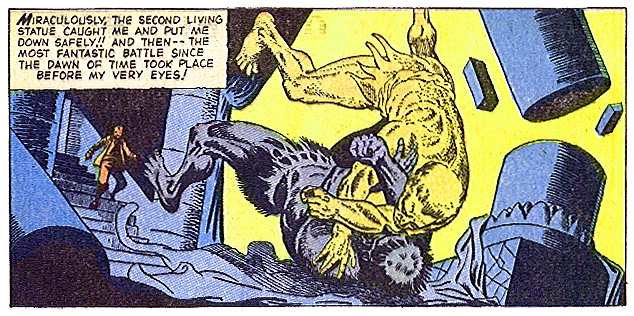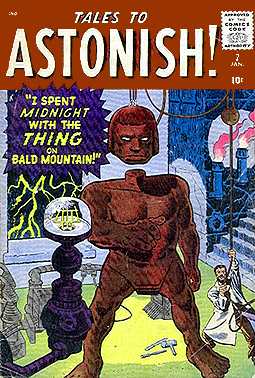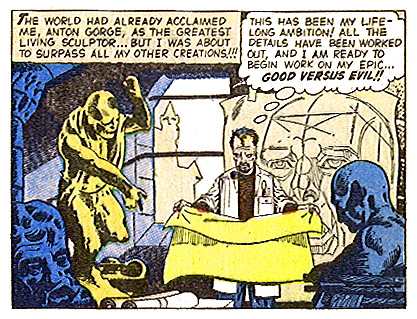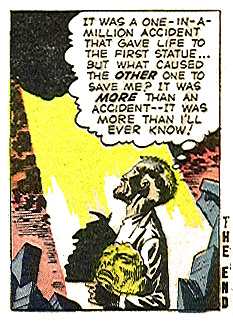Another fascinating aspect of Ditko Researching is to explore
elements of storytelling that appear in his pre-superhero work,
which then cropped up in later Ditko works.
One still can't hold these up as definites that Ditko (on the
front end) came up with the original ideas (could be Joe Gill,
could be Lee, as the writers), but it certainly creates interesting
possibilities, as at least we know Ditko was EXPOSED to such ideas,
whether they originated with him or not.
Good versus evil is as old as Cain and Abel, but Ditko (in
comics) certainly took this to his familiar extremes in his
later Objectivist-''tinged'' works.
Refer back to Tales To Astonish #7 (Jan '60) for
I SPENT MIDNIGHT WITH THE THING ON BALD MOUNTAIN. This proves
again Ditko rendered PLENTY of very tight tales for Marvel; pre-'61.
One just doesn't see some of the looseness associated
with SOME of his Charlton work (especially from the '58-9
period). Perhaps it was just inspiration; perhaps he was
just responding to better stories; perhaps he was just
responding to a better pay-cheque (who wouldn't?).
The story consists of a sculpture who builds two statues,
both of whom come to life via a bolt of lightning. The
sculptor is rescued by the GOOD statue, as both statues
brawl to their death.

The curious turn here is that the cover...

...has the sculptor only building one statue (no sight of
ANYTHING to do with the other statue or its materials), and
the title of the story does refer to THE Thing; nothing to
do with a plural nature. It is a Kirby cover, inked by Ditko,
so it stands to reason Lee told Kirby that this sculptor was
going to build ONE creation and then said sculptor would have
to survive its animation.
Might have Ditko added in the twist about the GOOD second statue
facing off about the EVIL one? Certainly, many of Lee's pre-superhero
stories involve an entity coming to life to hound a criminal, but I
can't provide many (if any) examples of another entity, on
the reverse moral side, coming to life to provide the moral
juxtaposition.
Panel Two on Page 2 of the story...

...is a far-shot of the sculptor's studio, and it could be regarded
as a fascinating look into the mind of how Ditko viewed himself, or
his workspace. It is a highly detailed panel, with plenty of grotesque
statues and faces, both in the background and foreground. And there is
the sculptor in the dead middle; perhaps symbolic. Either way, it is a
perfectly-laid out panel.
The final panel...

...also shows the sculptor holding the face of the
GOOD statue (now, magically reduced enough for him to be ABLE to
hold it in one hand) looking up to the heavens, as a beam of sunlight
encompasses him through a dark cloud. The sculptor is begging the
question as to what caused the accident and what saved his life.
The final morale seems to be illustrating the value of clinging
to the GOOD in life, versus the dark clouds that can overshadow
the light. So much in one panel says so much about Ditko's ability
to render the narrative in the visual, without the need for words
or explanation.
|

